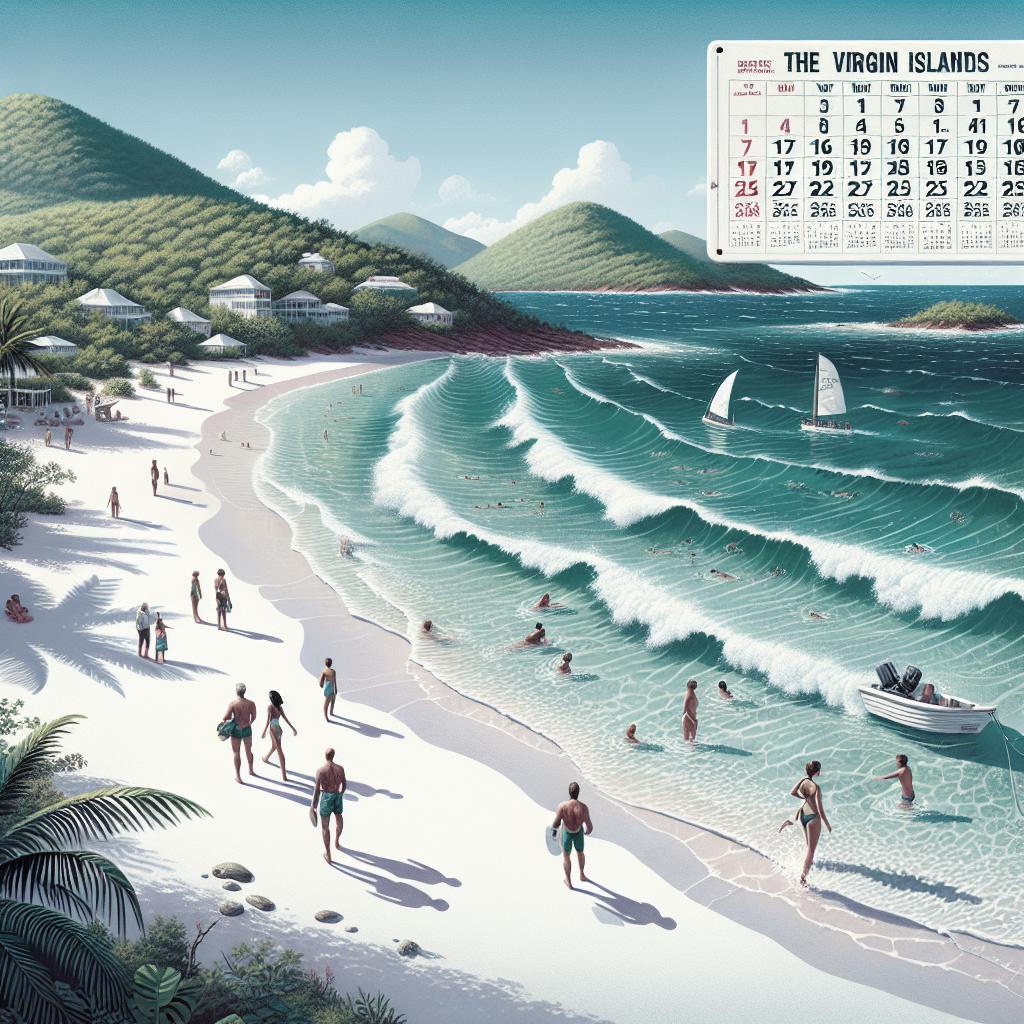The Virgin Islands, a tropical paradise in the Caribbean, boasts pristine beaches, crystal-clear waters, and a vibrant cultural heritage, making it an alluring travel destination year-round. However, planning a trip requires understanding the optimal times to visit to ensure you enjoy the islands to the fullest. This blog post will guide you through the best times to visit the U.S. Virgin Islands by examining its weather, peak tourist seasons, and key holidays and events. Additionally, we’ll break down each month to highlight what you can expect in terms of weather, crowd levels, and special events. This comprehensive guide will help you plan the perfect trip to the gorgeous Virgin Islands, ensuring that your experience is both memorable and enjoyable.
Weather in the US Virgin Islands
The U.S. Virgin Islands, comprising St. Thomas, St. John, and St. Croix, enjoy a tropical climate characterized by warm temperatures and gentle breezes year-round. Average temperatures typically range from 77°F (25°C) in the winter months to around 82°F (28°C) in the summer. The islands experience a dry season from December to April, with pleasant temperatures and lower humidity, making it a favorite time for visitors. The wet season, from May to November, brings higher humidity and more frequent rainfall. However, showers are usually brief, and sunny weather often follows. Hurricane season runs from June to November, with the highest risk between August and October. While hurricanes are rare, planning your trip with these considerations can ensure a smooth and enjoyable vacation.
Peak Tourist Season in the U.S. Virgin Islands
The peak tourist season in the U.S. Virgin Islands spans from December to April, coinciding with the dry season. During these months, the islands witness an influx of tourists seeking to escape the cold winter weather. Resorts, hotels, and beaches tend to be busier, and prices for accommodations and activities are higher due to increased demand. While the islands are bustling during this period, the festive atmosphere and numerous events create an exciting vibe. However, if you prefer a quieter experience with fewer crowds, consider visiting during the shoulder seasons, particularly in late spring or early fall when the weather is still pleasant, and the islands are less crowded.
Key Holidays & Events in the U.S. Virgin Islands
The U.S. Virgin Islands host several key holidays and events that bring the islands to life with vibrant celebrations and cultural displays. One of the most anticipated events is the Virgin Islands Carnival, held on St. Thomas in April. This lively festival features colorful parades, calypso music, dancing, and local cuisine, attracting visitors from around the world. In December, the St. Croix Christmas Festival transforms the island into a holiday wonderland with parades, concerts, and cultural events. Another significant event is Transfer Day on March 31, commemorating the transfer of the islands from Danish to U.S. rule in 1917. These celebrations offer unique opportunities to experience the rich cultural heritage of the Virgin Islands.
January
January is part of the dry season in the U.S. Virgin Islands, offering beautiful weather with temperatures ranging from 77°F (25°C) to 82°F (28°C). This month is ideal for beach activities, snorkeling, and exploring the islands’ natural beauty. The warm, sunny days and lower humidity make it a popular time for tourists, so expect higher prices and more crowded attractions. The New Year’s celebrations are lively, with fireworks and beach parties setting a festive tone for the year ahead. Visiting in January allows you to enjoy the best weather and participate in local events, making it a memorable start to your year.
February
February continues the trend of excellent weather, remaining a part of the dry season. With temperatures similar to January, it’s another great month for outdoor activities and beach relaxation. Water sports like sailing, kayaking, and diving are particularly enjoyable during this time, thanks to calm seas and clear waters. Valentine’s Day sees an influx of couples visiting the islands, adding a romantic touch to the atmosphere. If you’re planning a getaway with your significant other or just looking to bask in the Caribbean sun, February is a fantastic option.
March
March offers warm weather with temperatures around 79°F to 84°F (26°C – 29°C). As one of the last months of the dry season, it’s a prime time for visiting the islands. The milder climate and fewer rain showers create perfect conditions for exploring national parks, hiking trails, and off-the-beaten-path beaches. One key event in March is Transfer Day, celebrated on March 31. This historical day commemorates the transfer of the islands from Danish to American control in 1917. The celebrations include cultural displays, parades, and educational activities, providing visitors a glimpse into the islands’ rich history.
April
April marks the end of the dry season, with temperatures ranging from 79°F to 84°F (26°C – 29°C). Rainfall starts to increase slightly, but the weather remains pleasant for most outdoor activities. This month sees the beginning of the shoulder season, with fewer tourists and lower prices. One of the most vibrant events in April is the St. Thomas Carnival, a grand celebration featuring parades, music, dancing, and colorful costumes. Attending the carnival offers a unique opportunity to immerse yourself in the local culture and enjoy the island’s festive spirit.
May
May ushers in the start of the wet season, with temperatures between 81°F and 86°F (27°C – 30°C) and an increase in rainfall. Despite the occasional showers, May is still a pleasant time to visit, especially since the crowds have thinned out and prices are lower compared to peak season. The month also features the Virgin Islands National Park’s Beach-to-Beach Power Swim on St. John. This open-water swim event attracts participants of all skill levels, making it a thrilling experience whether you’re competing or spectating.
June
June brings warmer temperatures ranging from 82°F to 87°F (28°C – 31°C), and the wet season becomes more pronounced. While the chance of rainfall increases, the showers are usually brief and followed by sunny intervals. June also marks the beginning of hurricane season, so it’s wise to keep an eye on weather forecasts if you’re planning a trip. Despite the increased rainfall, June remains popular for family vacations as it coincides with school holidays in many countries. The islands remain vibrant, with plenty of activities and events to keep visitors entertained.
July
July continues the warm and humid trend, with temperatures between 82°F and 87°F (28°C – 31°C). The wet season is in full swing, and although rain showers are more frequent, they rarely last all day. This month also falls within the hurricane season, so travelers should stay updated on weather conditions. One of the highlights of July is the Emancipation Day celebration on July 3, commemorating the abolition of slavery in the Danish West Indies in 1848. The events include cultural performances, historic reenactments, and educational activities, offering visitors a deeper understanding of the islands’ history.
August
August experiences similar weather patterns as July, with temperatures ranging from 82°F to 87°F (28°C – 31°C) and increased rainfall. It’s another month within the hurricane season, so travel plans should be flexible and weather-aware. August remains a great time for immersing yourself in local culture. The St. John Festival, which begins in late June and runs through early July, offers an extended period of parades, music, food, and cultural events, making the islands a vibrant place to visit.
September
September is one of the wettest and most humid months in the U.S. Virgin Islands, with temperatures hovering around 81°F to 86°F (27°C – 30°C). This month also has the highest risk for hurricanes, so travelers are advised to be particularly cautious and stay informed about weather forecasts. Due to the increased likelihood of storms and heavy rainfall, September sees fewer tourists. However, this can be an advantage if you prefer a more secluded and quiet vacation experience, with less crowded beaches and attractions.
October
October continues the trend of high humidity and frequent rain showers, with temperatures ranging from 80°F to 85°F (27°C – 29°C). While it’s still within the hurricane season, the risk begins to diminish as the month progresses. Travelers should still remain cautious and flexible with their travel plans. Despite the wetter weather, October can be an appealing time to visit for those looking to escape the more crowded months. The islands’ lush green landscapes come alive during this period, offering a picturesque setting for photography and nature enthusiasts.
November
November marks the transition from the wet season to the dry season, with temperatures between 79°F and 84°F (26°C – 29°C). Rainfall decreases as the month progresses, making it a more favorable time for outdoor activities. The islands gradually start to see an increase in tourists, but it’s still less crowded compared to the peak season. One key event in November is Thanksgiving, which is celebrated with island-specific traditions and feasts. It’s a wonderful time to experience local hospitality and enjoy the island’s unique take on this American holiday.
December
December is the start of the dry season, with temperatures ranging from 77°F to 82°F (25°C – 28°C) and significantly reduced rainfall. This month marks the beginning of the peak tourist season, with an influx of visitors looking to escape winter weather and enjoy the festive atmosphere of the islands. The St. Croix Christmas Festival, which begins in December and continues into January, is a highlight of the month. It features parades, live music, and cultural events, creating a joyful and celebratory environment. December is a fantastic time to visit if you want to combine holiday celebrations with a tropical getaway. ### Lessons Learned By understanding the monthly weather patterns, key events, and tourist influxes, you can strategically plan your visit to the U.S. Virgin Islands for a truly unforgettable experience. Here’s a summary to help guide your decision: “`html
| Month | Weather | Tourist Activity | Key Events |
|---|---|---|---|
| January | Dry, 77°F-82°F | High | New Year’s Celebrations |
| February | Dry, 77°F-82°F | High | Valentine’s Day |
| March | Dry, 79°F-84°F | High | Transfer Day |
| April | Dry, 79°F-84°F | Moderate | St. Thomas Carnival |
| May | Wet, 81°F-86°F | Low | Beach-to-Beach Power Swim |
| June | Wet, 82°F-87°F | Moderate | Family Vacations |
| July | Wet, 82°F-87°F | Moderate | Emancipation Day |
| August | Wet, 82°F-87°F | Low | St. John Festival |
| September | Wet, 81°F-86°F | Low | Quiet, fewer events |
| October | Wet, 80°F-85°F | Low | Less crowded |
| November | Transition, 79°F-84°F | Moderate | Thanksgiving |
| December | Dry, 77°F-82°F | High | St. Croix Christmas Festival |
“`

